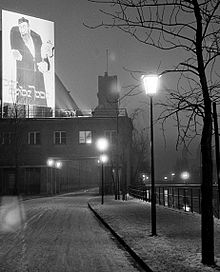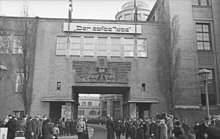The Eternal Jew (exhibition)
The Eternal Jew was the title of a touring exhibition organized by the National Socialists from November 1937 onwards , which served to further incite the population as part of the anti-Semitic ideology of racism.
Organizers
The initiator of the exhibition was, as was the case the year before, on November 7, 1936, also in the library building of the Deutsches Museum , the Great Anti-Bolshevik Exhibition , the deputy NSDAP - Gauleiter of Munich - Upper Bavaria Otto Nippold . The exhibition was organized by Walther Wüster , the deputy head of Gau propaganda , with the architect Fritz von Valtier and the painter Horst Schlüter responsible for the design .
course
The propaganda show, conceived as a traveling exhibition, took place for the first time in the library of the Deutsches Museum in Munich from November 8, 1937 to January 31, 1938 and was opened on November 8 by Joseph Goebbels and other Nazi figures.
The exhibition was the third show in a self-contained cycle of the so-called "shame exhibitions", which began in 1936 with the Great Anti-Bolshevik Show , followed by the Degenerate Art exhibition and continued with the exhibition The Eternal Jew .
Entry cost 50 pfennigs, and 35 pfennigs in advance sales by the NSDAP . The exhibition received the possibly effective advertising verdict “Young people have no access”, but the pupils of the Munich schools were guided through the exhibition class by class. The special postcard for the exhibition was sold out after a few days. The exhibition in Munich had 412,300 visitors.
The show was shown in the Nordwestbahnhalle in Vienna from August 2 to October 23, 1938 - the opening speech was given by Arthur Seyß-Inquart . The exhibition in Vienna showed photos of the former mayor Richard Schmitz and the cabaret artist Fritz Grünbaum , both imprisoned in the Dachau concentration camp , with the legend "Jews and servants in Dachau on summer vacation". The exhibition was also a great success in Vienna, attracting 350,000 visitors. The visit was compulsory for Viennese students.
The exhibition was shown in Berlin from November 12, 1938 to January 13, 1939 . In the shadow of the Reichskristallnacht , the exhibition in Berlin attracted a little less attention with 250,000 visitors.
From February 4 to March 5, the exhibition was guest in Bremen , from March 24 to April 23 in Dresden and finally from May 13 to June 11 in the Magdeburg city hall , where it was seen by 80,000 visitors.
During the German occupation of France, a similar exhibition with the title “Le Juif et la France” was shown in occupied France. For this, the Jewish advisor at the German embassy in Paris, Carltheo Zeitschel from Berlin, had requested support from Walther Wüster .
Content and interpretation
The first room dealt with the "biological foundations of Judaism " and thus served as a means of racist defamation. In the second room, the Jewish religion was the subject of disparaging, false and insulting interpretations. In the further course of the exhibition, the " history of Judaism " was thematized as a walk through world history, in which the Jews were depicted as omnipresent usurers and fenders who had to be locked in ghettos or driven out of self-defense .
The graphic execution of posters and lettering provide a characteristic example of the clichéd imagery of the anti-Semitic propaganda of the Nazi regime. On the basis of pictures and photographs, such as those of Leon Trotsky and Charlie Chaplin , whom the National Socialists wrongly dubbed Jews, so-called typical “Jewish characteristics” were to be highlighted. Furthermore, caricatures typical of the propaganda of the time, such as the type of the Eastern Jew in a caftan with gold coins and whip in his hands and a map of the world under his arm, combined with hammer and sickle symbolism, were intended to interweave anti-Semitic tendencies with the Bolshevik horror, which later appeared in the fifth leaflet the White Rose was criticized by Alexander Schmorell . So were conspiracy theories and alleged attempts by the Jews to the Sovietization of Germany manifold and exaggerated postulated (see also: Jewish Bolshevism ).
The exhibition, as well as the film of the same name, are therefore part of the history of the November pogroms in 1938 and the Holocaust that followed soon after , as ideologically they primarily served to remove the last moral scruples of the so-called Aryan population and to dehumanize the many later victims , who were previously normal citizens of everyday life, through artificial arousal of feelings of fear, envy and hate. According to police reports, there was a direct link between the exhibition and the increasing number of anti-Semitic attacks.
See also
- Propaganda film The Eternal Jew , 1940
literature
- Wolfgang Benz : "The Eternal Jew" (propaganda exhibition) . In: Handbook of Antisemitism - Events, Decrees, Controversies . tape 4 . De Gruyter, Berlin 2011, ISBN 978-3-598-24076-8 , pp. 114-117 .
Web links
- Postcard for the 1938 exhibition
- Opening on November 8, 1938 by Goebbels
- Reflection on the 2004 exhibition poster
- Rosemarie Burgstaller: The Eternal Jew (exhibition, 1937) , published on July 30, 2020; in: Historical Lexicon of Bavaria
Individual evidence
- ^ A b Wolfgang Benz: “The Eternal Jew” (propaganda exhibition) . In: Handbook of Antisemitism - Events, Decrees, Controversies . tape 4 . De Gruyter, Berlin 2011, ISBN 978-3-598-24076-8 , pp. 114-117 .
- ↑ Johannes Hürter (Red.): Biographical Handbook of the German Foreign Service 1871 - 1945. 5. T - Z, supplements. Published by the Foreign Office, Historical Service. Volume 5: Bernd Isphording, Gerhard Keiper, Martin Kröger: Schöningh, Paderborn a. a. 2014, ISBN 978-3-506-71844-0 , p. 112 f.
- ↑ Great power dream in the prayer room: Which exhibitions Munich schoolchildren visited 1933–1943 for each class ( Memento from May 3, 2014 in the Internet Archive ), by Brigitte Zuber, in: Insights and perspectives: Bavarian magazine for politics and history
- ^ Arthur Seyß-Inquart: Arthur Seyß-Inquart at the opening of the exhibition "The Eternal Jew". Vienna, Nordwestbahnhalle. (Sound excerpt). Austrian media library . August 2, 1938, accessed April 6, 2018 .
- ^ Serge Klarsfeld : Vichy - Auschwitz. The “Final Solution of the Jewish Question” in France , Translated from the French by Ahlrich Meyer , Nördlingen 1989; New edition 2007 by WBG , Darmstadt, ISBN 978-3-534-20793-0 , p. 386.




